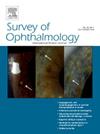The role of artificial intelligence in macular hole management: A scoping review
IF 5.1
2区 医学
Q1 OPHTHALMOLOGY
引用次数: 0
Abstract
We focus on the utility of artificial intelligence (AI) in the management of macular hole (MH). We synthesize 25 studies, comprehensively reporting on each AI model’s development strategy, validation, tasks, performance, strengths, and limitations. All models analyzed ophthalmic images, and 5 (20 %) also analyzed clinical features. Study objectives were categorized based on 3 stages of MH care: diagnosis, identification of MH characteristics, and postoperative predictions of hole closure and vision recovery. Twenty-two (88 %) AI models underwent supervised learning, and the models were most often deployed to determine a MH diagnosis. None of the articles applied AI to guiding treatment plans. AI model performance was compared to other algorithms and to human graders. Of the 10 studies comparing AI to human graders (i.e., retinal specialists, general ophthalmologists, and ophthalmology trainees), 5 (50 %) reported equivalent or higher performance. Overall, AI analysis of images and clinical characteristics in MH demonstrated high diagnostic and predictive accuracy. Convolutional neural networks comprised the majority of included AI models, including those which were high performing. Future research may consider validating algorithms to propose personalized treatment plans and explore clinical use of the aforementioned algorithms.
人工智能在黄斑孔管理中的作用:范围综述。
我们重点关注人工智能(AI)在黄斑孔(MH)管理中的应用。具体来说,我们研究了人工智能在黄斑孔的诊断、治疗和恢复中的作用。我们报告了每个人工智能模型的开发策略、验证、任务、性能、优势和局限性。我们对 5 个电子数据库进行了全面检索,包括 Ovid MEDLINE、EMBASE、Cochrane Central Register of Controlled Trials、Cochrane Database of Systematic Reviews 和 Web of Science Core Collection,检索时间从开始到 2023 年 9 月 26 日。共检索到 1,262 篇文章,其中 25 项研究符合纳入标准。人工智能模型的开发共使用了 209,443 张图像进行训练,30,011 张图像进行验证,223,592 张图像进行测试。共有 40 种不同的人工智能算法。有 22 项研究(88%)、1 项研究(4%)和 2 项研究(8%)分别采用了监督、无监督和综合人工智能策略。20项研究(80%)仅使用人工智能分析图像,5项研究(20%)同时分析图像和临床特征,包括患者人口统计学数据和MH的形态特征。12项研究(48%)使用人工智能进行诊断,5项研究(20%)确定了MH的特征,5项研究(20%)侧重于术后孔闭合和视力恢复的预测。没有文章对治疗计划进行研究。在将人工智能性能与人类分级人员进行比较的 10 项研究中,有 5 项(50%)根据其收集的定量性能指标指出了同等或更高的性能。总体而言,人工智能对 MH 图像和临床特征的分析显示出很高的诊断和预测准确性,14 项研究(56%)报告的性能指标值(包括准确性、灵敏度、特异性和精确度)超过 90%,曲线下面积超过 0.9。卷积神经网络占了所纳入人工智能模型的大多数,其中包括那些高性能的模型。未来的研究可能会考虑验证提出个性化治疗方案的算法,并探索上述算法的临床应用。叙述性摘要:这篇范围综述侧重于人工智能(AI)在黄斑孔(MH)治疗中的应用。本综述综合了 25 项研究,全面报告了每个人工智能模型的开发策略、验证、任务、性能、优势和局限性。所有模型都分析了眼科图像,其中 5 个模型(20%)还分析了临床特征。研究目标根据 MH 护理的三个阶段进行分类:诊断、MH 特征识别以及术后孔闭合和视力恢复预测。22个(88%)人工智能模型进行了监督学习,这些模型最常被用于确定MH诊断。没有一篇文章将人工智能用于指导治疗计划。人工智能模型的性能与其他算法和人类分级人员进行了比较。在将人工智能与人类分级人员(即视网膜专家、普通眼科医生和眼科受训人员)进行比较的 10 项研究中,有 5 项(50%)报告了同等或更高的性能。总体而言,人工智能对 MH 图像和临床特征的分析具有很高的诊断和预测准确性。卷积神经网络是大多数人工智能模型的组成部分,其中包括那些高性能的模型。未来的研究可能会考虑验证提出个性化治疗方案的算法,并探索上述算法的临床应用。
本文章由计算机程序翻译,如有差异,请以英文原文为准。
求助全文
约1分钟内获得全文
求助全文
来源期刊

Survey of ophthalmology
医学-眼科学
CiteScore
10.30
自引率
2.00%
发文量
138
审稿时长
14.8 weeks
期刊介绍:
Survey of Ophthalmology is a clinically oriented review journal designed to keep ophthalmologists up to date. Comprehensive major review articles, written by experts and stringently refereed, integrate the literature on subjects selected for their clinical importance. Survey also includes feature articles, section reviews, book reviews, and abstracts.
 求助内容:
求助内容: 应助结果提醒方式:
应助结果提醒方式:


